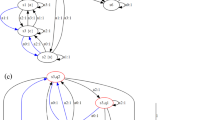Abstract
Priority specifications offer a convenient description technique to resolve conflicts in favour of particular actions. Apart from being employed for the specification of the functional behaviour of a system, priorities have also become important in the field of performance analysis using stochastic Petri nets. Here they are implicitly given due to the separation of transitions into immediate and timed. In the performance analysis of such stochastic Petri nets specific properties, like liveness and existence of home states, are of major interest, because they ensure the applicability of a Markovian based analysis. Since several efficient analysis techniques have been developed for Petri nets without priorities, our interest is in using these techniques also for the priority case. This paper shows that positive properties of a net such as liveness and the existence of home states do also hold for the net with static priorities, if a simple condition is imposed on the priority relation.
Similar content being viewed by others
References
M. Ajmone-Marsan. Stochastic Petri nets: An elementary introduction. In Advances in Petri Nets, pages 1–29. Lecture Notes in Computer Science, Vol. 424, Springer-Verlag, 1989.
M. Ajmone-Marsan, G. Balbo, and G. Conti. Performance Models of Multiprocessor Systems. MIT Press Series in Computer Science, 1986.
B. Alpern and F.B. Schneider. Defining liveness. Information Processing Letters, 21:181–185, 1985.
E. Best. Structure theory of Petri nets: The free choice hiatus. In Advances in Petri Nets, Part I, pages 168–205. Springer-Verlag, 1986.
E. Best, J. Desel, and J. Esparza. Traps characterize home states in free choice systems. Theoretical Computer Science, 101:161–176, 1992.
E. Best and M. Koutny. Petri net semantics of priority systems. Theoretical Computer Science, 96:175–215, 1992.
E. Best and P.S. Thiagarajan. Some classes of live and safe Petri nets. In Advances in Petri Nets, pages 71–94. Springer-Verlag, 1987.
E. Best and K. Voss. Free choice systems have home states. Acta Informatica, 21:89–100, 1984.
G. Chiola, M. Ajmone-Marsan, G. Balbo, and G. Conte. Generalized Stochastic Petri nets: A definition at the net level and its implications. IEEE Transactions on Software Engineering, 19(2):89–107, Feb. 1993.
G. Chiola, S. Donatelli, and G. Franceschinis. Priorities, inhibitor arcs, and concurrency in P/T nets. In Proceedings of the 12th International Conference of Application and Theory of Petri Nets, Gjern (Denmark), 1991.
M.H.T. Hack. Petri net languages. Technical Report 159, MIT, Laboratory of Computer Science, March 1976.
R. Janicki. A formal semantics for concurrent systems with a priority relation. Acta Informatica, 24:33–55, 1987.
P. Kemper. Linear time algorithm to find a minimal deadlock in a strongly connected free-choice net. In M. Ajmone-Marsan, editor, Proceedings of the 14th International Conference on Application and Theory of Petri Nets, pages 319–338. Springer-Verlag, Berlin, 1993.
P. Kemper and F. Bause. An efficient polynomial-time algorithm to decide liveness and boundedness of free choice nets. In K. Jensen, editor, Proceedings of the 13th International Conference on Application and Theory of Petri Nets. Springer-Verlag, Berlin, 1992.
M. Koutny. Modelling systems with dynamic priorities. Advances in Petri Nets, pages 251–266, 1992.
A. Pagnoni. Stochastic nets and performance evaluation. In Petri Nets: Central Models and Their Properties. Advances in Petri Nets, pages 460–478. Lecture Notes in Computer Science, No. 254, 1986.
J.L. Peterson. Petri Net Theory and the Modelling of Systems. Prentice-Hall, 1981.
P.S. Thiagarajan and K. Voss. In praise of free choice nets. In Advances in Petri Nets, pages 438–454. Springer-Verlag, 1984.
W.J. Stewart. Introduction to the numerical solution of Markov chains. Princeton University Press, 1994.
E. Teruel and M. Silva. Liveness and home states in equal conflict systems. In Proceedings of the 14th International Conference on Application and Theory of Petri Nets, Chicago (USA), pages 415–432, 1993.
E. Teruel and M. Silva. Well-formedness of equal conflict systems. In Proceedings of the 15th European Workshop on Application and Theory of Petri Nets, Zaragoza (Spain), pages 491–510, 1994.
W. Vogler. Live and bounded free choice nets have home states. In Petri Net Newsletters, pages 18–21. Special Interest Group On Petri Nets and Related System Models, Gesellschaft für Informatik (GI), Germany, 4 1989.
Author information
Authors and Affiliations
Corresponding author
Rights and permissions
About this article
Cite this article
Bause, F. On the analysis of Petri nets with static priorities. Acta Informatica 33, 669–685 (1996). https://doi.org/10.1007/BF03036470
Received:
Issue Date:
DOI: https://doi.org/10.1007/BF03036470




